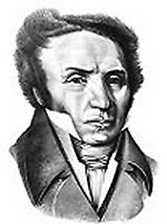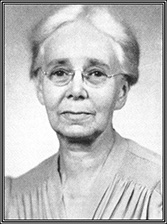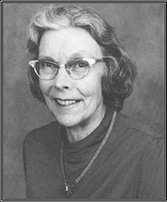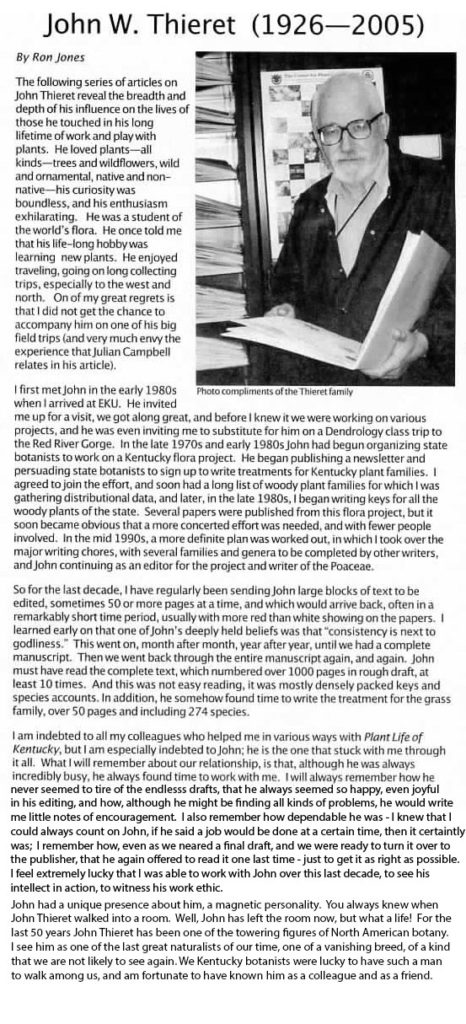2016 Inductee
John W.Thieret
2015 Inductees
André Michaux
Constantine Rafinesque
E. Lucy Braun
Mary E. Wharton
Article By Ronald Jones
Ronald Jones, Wilson Francis, and David Taylor—KBHOF Selection Committee Members
At a meeting in early 2015, the Kentucky Native Plant Society Board voted to establish a “Kentucky Botany Hall of Fame.” The intent of this Hall of Fame would be to recognize those people that had left a “substantial and long-lasting impact” on our knowledge of the flora and vegetation of the Commonwealth. No other particular criteria were thought necessary. The inductees could include, but not be limited to, professional botanists, ecologists, teachers, au-thors of articles or books on botanical topics, amateur naturalists, conservationists, and oth-ers who have helped to discover and document the botanical resources of the state. A com-mittee of three KNPS members was selected, and charged with developing a plan to initiate this project. The committee decided to select four inductees for the initial class, and after-ward, add one new inductee per year. In this first year the selection committee nominated and voted on the initial class. In future years the selection committee as well as KNPS mem-bers can nominate candidates for the recognition. The Kentucky Botany Hall of Fame will be featured on the KNPS website, and include images and biographical accounts of their contri-butions to Kentucky botany. The KBHOF Selection Committee had very little trouble coming with the first four inductees, these representing the 18th, 19th, and 20th centuries, and it is obvious that all of these four individuals had a huge impact on Kentucky botany.
Note: some of this material is taken from Plant Life of Kentucky (Jones 2005).
André Michaux (1746—1802) André Michaux can be called the father/founder of Kentucky botany.

His descriptions of the region were important glimpses into Kentucky’s past. He collect-ed prolifically and subsequently described many spe-cies found in the state. His work set the stage for several following botanists including his son, Franciois Michaux and Constantine Rafinesque. In addition, with his continental flora, he did much to usher in North American botany. André Michaux was born in 1746 near Versailles, France. Trained to take over as superintendent of a wealthy landowner’s estate, he abandoned this career after the death of his newlywed wife, and turned his attention to botany. He quickly made a name for himself in botanical circles in France and became a plant col-lector for the royal gardens in Paris. In 1785 he traveled to North America accompanied by his 15 year-old son, François, who also became a not-ed botanist. He constructed botanical gardens in New Jersey and in Charleston, South Carolina, and ex-plored eastern North America for 11 years, traveling through Kentucky several times between 1793 and 1796, making numerous collections and eventually describing many new genera and species (nearly 300 plant species in Kentucky were first described by Michaux). His book 1803 Flora Boreali-Americana, published posthumously, was the first flora of North America based entirely on the author’s own botanical studies. Michaux’s collections in Kentucky helped provide the foundation for this great work. His name is commemorated as an epithet for several species, including Croton michauxii (now Croton linearis), Hedyotis michauxii (now Houstonia serpyllifolia), Quercus michauxii and Saxifraga michauxii. He also provided some of the earliest descriptions of the vegetation of the central Kentucky region, noting, for example, the unusual set of species in the Bluegrass region. André Michaux returned to France in 1796 with his many plant collections, which are still preserved in the Michaux Herbarium in Paris. Over the next four years he worked on his book, but it was yet to be published when he set sail for the South Seas on another botanical expedition. He never returned to Paris, succumbing to malaria on Madagascar in 1802 (although there are some reports that he was alive at least until 1810). There are many websites devoted to André Michaux, and these describe many other interesting aspects of his life, such as being offered a “Lewis and Clark” type expedition by President Jefferson a decade before the Corps of Discovery Expedition, and acting as a spy for the French government, attempting to recruit Ameri-can frontiersmen (in Kentucky) to join forces with the French to oust the Spanish from Louisiana.
Constantine Samuel Rafinesque (1783—1840)

Image courtesy of Transylvania University
Constantine Rafinesque has generated more interest in his life and work than any other American naturalist. He explored Kentucky from 1818 until 1825, collecting perhaps 10,000 specimens, and, in his career, pub-lished over 900 books and articles, described thousands of new genera and species (mostly plants). He re-mains a source of fascination, as articles and books that discuss Rafinesque continue to be published to this day. His Kentucky legacy is forever tied to that of Dr. Charles Short, to Transylvania University and the “infamous curse,” and to his botanical collecting and publishing on the flora of Kentucky.
Born in Turkey and raised in France, Rafinesque was a child prodigy
and already a learned naturalist when he arrived in America at the age
of 20. He later described himself as a botanist, naturalist, geolo-gist,
geographer, historian, poet, philosopher, economist, and
philan-thropist. He botanized for a few years in the middle Atlantic
states, then returned to Europe, lived in Sicily for about 10 years, and
re-turned to America in 1815 with a cargo of botanical drugs and 50
boxes of books and collections, all of which he lost in a shipwreck off
Block Island, New York.
Discouraged but full of excitement about all the discoveries that
awaited him, Rafinesque launched himself into a frenzy of activity over
the next few years, traveling back and forth across the Alleghe-nies.
From 1818 to 1826 Rafinesque focused his attentions almost entirely on
Kentucky. An encounter with John James Audubon in Henderson Kentucky in
1818 produced several stories that have be-come legendary (see the
accounts concerning Audubon’s violin and his drawings of a fake fish).
Rafinesque eventually made his way to Lexington and secured a position
as a Professor of Botany and Natu-ral History at Transylvania
University, a position he held until 1825. He traveled mostly in central
and western portions of the state, col-lecting thousands of specimens
in Kentucky. Early on he established a working relationship with Dr.
Charles Short, the renowned Kentucky botanist, but this association
eventu-ally soured due to their different standards relating to
information exchange and specimen preparation. He published Florula
Kentuckiensis in 1824, the first general account of the plant life of
the state.
After a disagreement with Horace Holley, the president of the
university, in the Fall of 1825, he departed Kentucky in 1826. He
famously left a curse on the university, and, curiously, President
Holley soon lost his position, contracted yellow fever and passed away
from the disease, and in addition, the university admin-istration
building burned down! Eventually Rafinesque settled in Philadelphia, but
there he fell upon hard times, and died in 1840.
During his lifetime this prodigious naturalist proposed more new
names than any other American naturalist, a phenomenal total of about
2700 new genera and nearly 6900 new species, the majority being vascular
plants. His work was generally frowned upon by his contemporaries, for a
number of reasons, including his difficult personality, his fanatical
desire to describe new species, and his atypical methods of publishing
his discoveries.
Sadly, most of his lifetime collections (containing an estimated
50,000 specimens and possibly 10,000 Ken-tucky specimens) have been
lost. His herbarium was put on public sale, but without a single bidder
it was left abandoned in a storage room, where the collection was
heavily damaged by rats. Most specimens became very damaged and were
discarded. Although some of his specimens remained at other herbaria,
including some type specimens, there seems no doubt that thousands of
possible type specimens were lost. It was a tragic loss for botanical
science and for Kentucky botany.
Rafinesque’s many eccentricities are legend but there is no doubt of
his legacy. His published articles and books total over 900 titles.
Included among them is the first descriptive outline of the vegetation
regions of Kentucky, as well as the first general account of the plant
life of Kentucky He also wrote a Medical Flora (1828-1830) that had
great influence on the development of medical botany in the United
States His many descriptions of new genera and species have been studied
over the last few decades, and many of his names have been resurrected.
Over 100 genera and species in Kentucky bear the “Raf.” author
citation. Among the species named in memory of Rafinesque are Viburnum
rafinesquianum and Viola rafinesquii.
E. Lucy Braun (1889—1971)

. Image courtesy of Hunt Institute for Botanical Documentation
E. Lucy Braun was the most active botanical researcher and publisher on the Kentucky flora and vegetation during the 1930s and 1940s. She published the first detailed plant species list for Kentucky, described new plant species for the state, and conducted some of the first large scale vegetation studies in the state. E. Lucy Braun was a life-long resident of Cincinnati, attending the University of Cincinnati for all her degrees, studying geolo-gy at the bachelor’s and master’s level, and earning a Ph.D. in botany in 1914. She was the second woman to earn a Ph.D from the University of Cincinnati (her sister Annette was the first). The title of her dissertation was “The physiographic ecology of the Cincinnati region.” She remained at the university for the remainder of her career, beginning as a geology teaching assistant, and ending as a full professor of plant ecology, retiring in 1948 to devote her time to research.
She also holds the distinctions of being the first woman elected to the Ohio Conservation Hall of Fame, and the first woman elected president of the Ecological Society of America. She began collecting plant specimens while in high school, and continued collecting throughout her career, accumulating over 12,000 herbarium specimens, many of these from Kentucky (these were eventually sent to the Smithsonian Institute and are still housed there). She wrote four books and about 180 journal articles, with nearly two dozen of these devoted to Kentucky topics. Included in her publications were the descriptions of several new species and varieties, including two of Kentucky’s most endangered plants––Arabis perstellata and Solidago albopilosa. In addition, several species and varieties have been named in honor of Dr. Braun, including Ageratina luciae-brauniae, and Silphium terebin-thinaceum var. luciae-brauniae. Her most significant publication on Kentucky botany was the Annotated Cat-alog of Spermatophytes of Kentucky, published in 1943, which gave detailed accounts for 1636 species, varie-ties, forms, and hybrids. Braun’s list contained habitat information and county distributions. It remained the only annotated checklist of Kentucky plants for nearly 50 years. During her Kentucky studies, she traveled with her sister Annette, often visiting remote areas of Appalachian Kentucky (where it is said that they often encountered moonshiners but always tried to make friends so that they could explore the mountains). Included in her Kentucky publications were landmark studies of the flora and vegetation of Pine Mountain and Black Mountain. Although she accomplished much floristic work, Braun’s primary focus was plant ecology, and her magnum opus was the monumental Deciduous Forests of Eastern North America, published in 1950. In this book Braun described and classified the different forest types of eastern North America. To this day it is required reading for students of plant ecology throughout the region. Her other major books included treatments of the woody plants and monocots of Ohio, published in 1961 and 1967, and these also were of regional significance and have been invaluable to the work of Kentucky botanists.
Mary E. Wharton (1912—1991)

Photo courtesy of Mary E. Wharton estate
Mary E. Wharton conducted one of the most classic botanical studies in Kentucky history—her Ph.D. dissertation on the Knobs region of Kentucky. In addition, her popular books introduced many students and members of the public to the more common plant species of Kentucky and these books remain popular today. She was also a strong advocate for conservation of natural lands, practicing what she preached. Her legacy lives on in her publications and in the Floracliff Nature Sanctuary. Mary Wharton grew up in Lexington, Kentucky, and at-tended the University of Kentucky, graduating with de-grees in botany and geology. She completed her Ph.D. at the University of Michigan in 1945, and her dissertation topic was the flora and vegetation of the Devonian-Missisippian black shale regions of Kentucky. This study of the Knobs region, the most comprehensive region-wide study yet attempted in Kentucky, resulted in the documen-tation of over 1000 taxa in the area. One of Wharton’s collections of a dewberry species was named in her honor, Rubus whartoniae. A complete set of her specimens from the Knobs study were donated to the growing collection at the University of Kentucky, but unfortunately, these were lost when the UK Herbarium was completely de-stroyed by fire in 1948 (but many duplicates remained at other herbaria). Wharton accepted a teaching positon at Georgetown College in Georgetown, Kentucky, and was associated with Georgetown College for the remainder of her professional career. During her long career, she, in collaboration with Roger Barbour, produced a se-ries of popular books dealing with the Kentucky flora, including books on wildflowers and ferns in 1971 and trees and shrubs in 1973. Her final book, also written with Roger Barbour, was Bluegrass Land & Life, published just prior to her death in 1991. This latter work represented the culmination of her outstanding career; it included a list of 1149 plant species of the flora of the Inner Bluegrass, and was her final plea for protection of the disappearing natural resources of the Bluegrass. For 30 years the books authored by Wharton and Barbour were the only illustrated reference books for identifying the genera and species of Kentucky plants, and they remain popular to this day. Wharton was also an envi-ronmental activist throughout her life, and was involved in the fight to protect the Red River Gorge in the 1970s. She also established a 287 acre preserve on the Kentucky River in Fayette County, and named it Floracliff. The Floracliff Nature Sanctuary has now been dedicated as a Kentucky State Nature Preserve, and it provides workshops and many kinds of educational and research opportunities for Kentucky citizens. There is no doubt that the legacy of Mary E. Wharton to Kentucky botany has been substantial and long lasting.
John W. Thieret (1926-2005)

